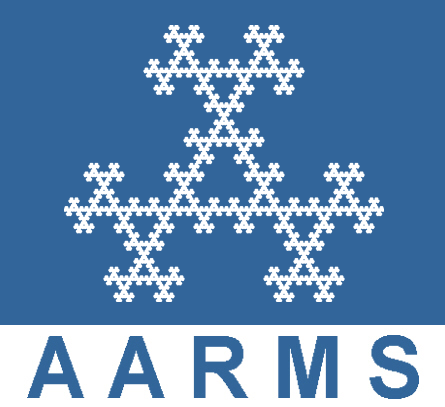2017 CMS Winter Meeting
Waterloo, December 8 - 11, 2017
Org: Sara Faridi (Dalhousie University) and Adam Van Tuyl (McMaster University)
[PDF]
- MINA BIGDELI, Institute for Research in Fundamental Sciences (IPM)
Chordal clutters vs. collapsible simplicial complexes [PDF]
-
A challenging problem in combinatorial commutative algebra is to give a characterization of the uniform clutters whose associated ideals have a linear resolution independent of the characteristic of the base field. Thanks to Fr\"oberg, the problem is solved in the case of $2$-uniform clutters. In this talk, we first define a reduction process on a uniform clutter $\mathcal{C}$ under which the non-linear Betti numbers of the ideal $I(\bar{\mathcal{C}})$ do not change. Motivated by this result, we define a class of $d$-uniform clutters called chordal which partially generalize the result of Fr\"oberg. We then extend this notion to simplicial complexes and compare this class with the class of collapsible simplicial complexes.
This talk is mainly based on a joint work in progress with Sara Faridi and a joint work with Ali Akbar Yazdan Pour and Rashid Zaare-Nahandi.
- GIULIO CAVIGLIA, Purdue University
Extremal free resolutions over monomial complete intersections. [PDF]
-
Let $S$ be a polynomial ring over a field $k$ of characteristic 0,
and let $R$ be a complete intersection in $S$ defined by powers of the variables.
We prove that, in the Hilbert scheme parametrizing the closed subschemes of Proj $R$ with a fixed Hilbert polynomial $p$, there exists a point whose saturated ideal $I$ achieves the largest possible Betti numbers in the finite free resolution of $R/I$ over $S$ and in the infinite free resolution of $R/I$ over $R$. In the case of a regular ring, the ideal $I$ also maximizes
the infinite free resolution of $k$ over $R/I$. This is a joint work with Alessio Sammartano.
- ALEXANDRU CONSTANTINESCU, INdAM, Rome
Linear syzygies and hyperbolic Coxeter groups [PDF]
-
We show that the virtual cohomological dimension of a Coxeter group is essentially the same as the Castelnuovo-Mumford regularity of the Stanley-Reisner ring of its nerve. Using this connection, we modify a construction of Osajda in group theory to find for every positive integer $r$ a quadratic monomial ideal, with linear syzygies, and regularity of the quotient equal to $r$. This answers a question of Dao, Huneke and Schweig, and shows that Gromov asked essentially the same question about the virtual cohomological dimension of hyperbolic Coxeter groups. For monomial quadratic Gorenstein ideals with linear syzygies we prove that the regularity of their quotients can not exceed four, which implies that for $d > 4$ every triangulation of a $d$-manifold has an induced square or a hollow simplex. All results are in collaboration with Thomas Kahle and Matteo Varbaro.
- ANTON DOCHTERMANN, Texas State University
Coparking functions and h-vectors of matroids [PDF]
-
The $h$-vector of a simplicial complex $X$ is a well-studied invariant with connections to algebraic aspects of its Stanley-Reisner ring. When $X$ is the independence complex of a matroid Stanley has conjectured that its $h$-vector is a ‘pure O-sequence’, i.e. the degree sequence of a monomial order ideal where all maximal elements have the same degree. The conjecture has inspired a good deal of research and is proven for some classes of matroids, but is open in general. Merino has established the conjecture for the case that $X$ is a cographical matroid by relating the $h$-vector to properties of chip-firing and `$G$-parking functions' on the underlying graph $G$. We introduce and study the notion of a ‘coparking’ function on a graph (and more general matroids) inspired by a dual version of chip-firing. As an application we establish Stanley’s conjecture for certain classes of binary matroids that admit a well-behaved `circuit covering'. Joint work with Kolja Knauer.
- FEDERICO GALETTO, McMaster University
Distinguishing k-configurations [PDF]
-
A $k$-configuration in the projective plane is a collection of
points, subject to certain geometric conditions, introduced by
Roberts and Roitman to study Hilbert functions of graded
algebras. If $d$ is the maximal number of colinear points in a
$k$-configuration, then there can be anywhere between 1 and $d+1$
distinct lines containing exactly $d$ points of the
$k$-configuration. The number of such lines is not detected by the
usual invariants of the defining ideal of the
$k$-configuration. Instead, I will illustrate how this number of
lines is encoded in the Hilbert function of a high enough symbolic
power of the defining ideal of the $k$-configuration. This talk is
based on joint work with Y.S. Shin and A. Van Tuyl
(arXiv:1705.09195).
- TAI HA
Depth and regularity modulo a hypersurface [PDF]
-
We shall discuss the relationship between the depth and Castelnuovo-Mumford regularity of a homogeneous ideal $I$ and those of $(I,f)$ and $(I:f)$, where $f$ is a linear form or a monomial. We shall also give a number of interesting applications when $I$ is the edge ideal of a hypergraph or a power of a given homogeneous ideal.
- JOHANNES HOFSCHEIER, McMaster University
Spanning Lattice Polytopes and the Uniform Position Principle [PDF]
-
A lattice polytope is called spanning if its lattice points affinely span the ambient lattice. This property can be translated to a natural algebraic property of the Ehrhard ring of the polytope. In this talk, I will present recent joint work with Lukas Katthän and Benjamin Nill where we generalize the Uniform Position Principle due to Harris to obtain new inequalities between the coefficients of the $h^*$-polynomial of a spanning lattice polytope. These inequalities generalize and unify inequalities by Stanley and Hibi.
- SUSAN MOREY, Texas State University
Depths and Cohen-Macaulay Properties of Monomial Ideals [PDF]
-
This talk will focus on classes of monomial ideals that have a graphical representation. Classes will include square-free monomial ideals, which have a variety of representations including edge ideals of clutters or generalizations of path ideals of graphs. The talk will also include classes of monomial ideals that while not square-free, still have a graphical representation, such as edge ideals of directed graphs, powers of edge ideals or polarizations of monomial ideals. The goal will be to use a combination of algebraic and combinatorial techniques to determine information about depth properties of these ideals, with a particular interest in when the ideals are Cohen-Macaulay.
- SATOSHI MURAI, Osaka University
Face numbers and the fundamental group [PDF]
-
In this talk, I show two lower bounds of $h_2$-numbers of simplicial complexes in terms of the minimum number of generators of their fundamental groups. I will also explain a nice relation between the polyhedral Morse theory and graded Betti numbers, which is used to relate numbers of generators of fundamental groups and $h_2$-numbers.
This is a joint work with Isabella Novik.
- CONNOR SAWASKE, University of Washington
Lower bound theorems for balanced manifolds [PDF]
-
Juhnke-Kubitzke and Murai proved a balanced generalized lower bound theorem for simplicial polytopes. We extend their result to balanced triangulations of orientable homology manifolds whose proper links have the weak Lefschetz property. As a corollary, we prove a conjecture of Klee and Novik that if $\Delta$ is a balanced triangulation of a connected $(d-1)$-dimensional orientable homology manifold, then $2h_2(\Delta)-(d-1)h_1(\Delta)\ge 4{d\choose 2} \tilde{\beta}_1(\Delta)$.
- MAYADA SHAHADA, Dalhousie University
Well Ordered Facet Covers and the Subadditivity Property of Monomial Ideals [PDF]
-
It is known that the subadditivity property for the maximal degrees of the syzygies of a graded ideal of a polynomial ring $K[x_1,\ldots,x_n]$ fails to hold, while, under restrictive conditions, many cases have been known to hold. On the other hand, the problem is still open for the class of monomial ideals and has been investigated by several researchers and using different approaches.
In this talk, we will present the problem in terms of facet covers of simplicial complexes as defined by Erey and Faridi (2015): a subset $\{F_1,\ldots,F_i\}\subseteq$ Facets$(\Gamma)$ of facets of a simplicial complex $\Gamma$ is called a facet cover of $\Gamma$ if every vertex $v$ of $\Gamma$ belongs to $F_j$ for some $1\leq j \leq i$. A facet cover is called minimal if no proper subset of it is a facet cover of $\Gamma$. A minimal facet cover $\{F_1,\ldots,F_i\}$ is called well ordered if, for every facet $H \notin \{F_1,\ldots,F_i\}$ of $\Gamma$, there exists $k \leq i-1$ such that $$F_k \subseteq H\cup F_{k+1} \cup \cdots \cup F_i.$$
- VOLKMAR WELKER, Universitaet Marburg
Lovasz-Saks-Schrijver ideals and coordinate sections of determinantal varieties [PDF]
-
In this work (joint with A. Conca) we study two classes of ideals associated to a graph $G$.
The Lovasz-Saks-Schrijver (LSS) ideals and ideals of minors
of generic (symmetric) matrices with $0$s in positions prescribed by the
graph $G$. The goal of this paper is to link the combinatorial structure of
$G$ to algebraic properties of the ideals. In particular, we are interested in
asymptotic behavior. We show that LSS ideals are asymptotically prime complete
intersections. We show that radicality or primality of LSS ideals
implies the same property for the ideals minors associated to the same graph.
Several of our results are inspired by geometric results from the work of
Lovasz, Saks and Schrijver and by results of Giusti and Merle.
- RUSS WOODROOFE, University of Primorska
Order congruence lattices have convex ear decompositions [PDF]
-
A convex ear decomposition of a simplicial complex writes the complex as an ordered union of simplicial polyhedra (and certain portions thereof) that obeys certain restrictions reminiscent of those for a shelling. Complexes with convex ear decompositions are doubly Cohen-Macaulay, and inherit strong relationships on their $f$- and $h$-vectors from the Lefschetz property for simplicial polyhedra.
In joint work with Jay Schweig, we have produced a convex ear decomposition for the order congruence lattice of any finite poset. An essential tool is the shellability and comodernism of these lattices.





